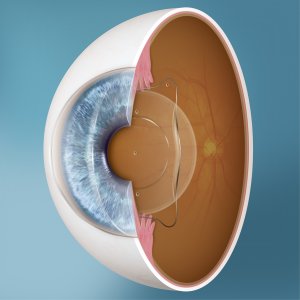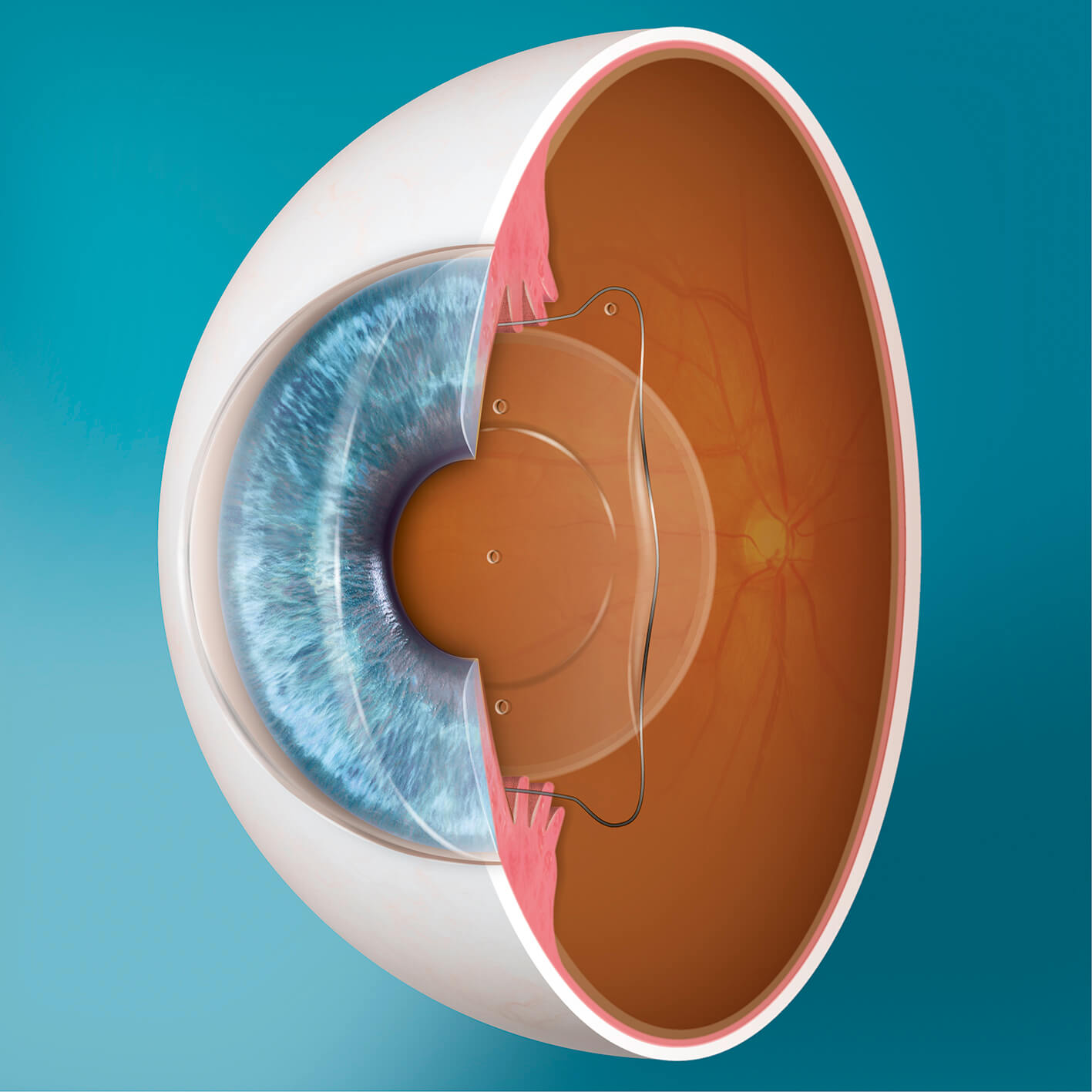The Implantable Collamer Lens (ICL)
Phakic intraocular lens implantation is most commonly performed using the ICL made by Staar Surgical.
ICL implantation is the most commonly performed type of Phakic Intraocular Lens Implantation.

This involves implanting a small, thin lens behind the iris and in front of the natural crystalline lens of the eye. ICLs are extremely versatile and can treat almost every possible prescription: in the UK, the lens is available to treat short-sightedness from -0.50 to -18.00 D, long-sightedness from +0.50 D to +10.00 D and astigmatism up to 6.00 D.
The lens also comes in various sizes to accommodate different eye sizes.
While earlier lenses were found to be linked to a higher risk of cataract formation, more modern models, including the EVO Visian ICL, feature a tiny hole – known as the aquaport – in the centre of the lens. This allows for a better flow of aqueous and nutrients around the eye’s natural lens, which was believed to be a contributor to the cataract risk of previous models.
The EVO Visian ICL is largely used for the treatment of myopia (short-sightedness). In contrast, these lenses are not used in patients with hyperopia (long-sightedness). Therefore, long-sighted patients may have to have a very short laser procedure a few days before lens implantation to create a hole in the iris for fluid to flow through. This procedure is very straightforward and only takes around one minute per eye.
To date, over 1 million ICLs have now been implanted worldwide.
Eligibility for ICL Surgery
Before being approved for ICLs, patients will undergo extensive examinations – just like Laser Eye Surgery patients. This is particularly important as many candidates for ICLs have high short-sightedness due to an elongated eye. Conducting a thorough examination of the vitreous and retina through a dilated pupil is, therefore, essential.
Furthermore, it is also best practice to document the health of the peripheral retina with state-of-the-art wide-field imaging as certain retinal pathology can significantly affect the success rate of phakic intraocular surgery.
Finally, it may also be necessary for a retinal specialist to evaluate the stability and health of your retinas. In some cases, patients may require treatment for asymptomatic retinal holes or tears before being approved for ICL surgery.
ICL Procedure
Unlike Laser Eye Surgery procedures, ICL surgery is usually performed on one eye at a time with 1-3 days between each eye. The procedure itself takes around 10 minutes and will be followed by a final check, including an eye pressure and lens position review.
ICL patients typically use lubricating eye drops for 2-3 weeks following the procedure.
After the procedure
Most patients will be able to return to normal activities the morning after their surgery; however, several restrictions will be recommended by your surgeon, including no eye rubbing, swimming, intense physical activity, and avoiding dusty or dirty environments. If the eye is stable at your one-week follow-up appointment, these restrictions will be lifted.
As with Laser Eye Surgery, there may be a small prescription remaining following ICL surgery. This remaining error tends to be very small and can often be addressed with glasses and contact lenses or refractive surgery (assuming you have no corneal conditions which precluded you from laser treatment in the first place).
You may also experience a small amount of glare and halo in the weeks and months immediately following the procedure. In some cases, a mild eye drop can help to reduce the impact of these side effects. It is extremely rare to have an ICL removed for subjective reasons; however, as the procedure does not alter the natural state of the eye, it is possible to have the lenses removed without your vision affecting your pre-corrected vision.
Risks and Complications of ICLs
The most common risks associated with ICL surgery are pupillary block, cataract formation, increased, and glaucoma. These occurrences are rare and most cases are associated with the use of incorrectly sized lenses.
ICLs come in four sizes. The suitable lens size is determined based on measurements taken during the comprehensive preoperative evaluation. Most providers use exterior measurements of the eye to estimate the dimensions on the inside of the eye. These measurements can then be used to select the right lens size.
However, this isn’t always an effective way to determine the internal measurements of the eye. In some cases, exterior measurements do not correlate sufficiently with the internal anatomy of the eye.
More accurate measurements can be collected using the latest technology – in this case, the Artemis Insight 1000 VHF digital ultrasound scanner. This technology allows surgeons to directly measure the area inside the eye where the lens will be sitting, making for more accurate sizing.
If you are considering ICLs, you should ensure that your provider uses the latest technology and methods to minimise the chance of complications after your surgery or the need for an ICL exchange surgery.

